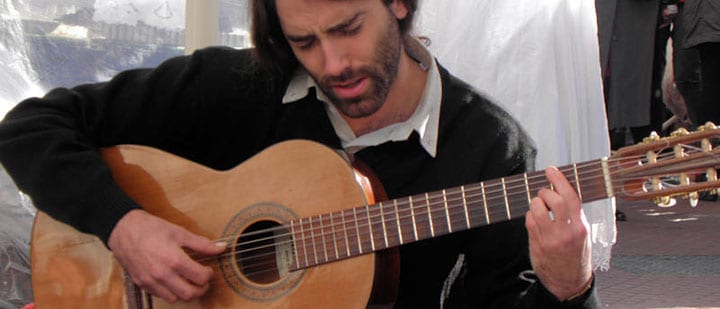How much will it really cost you to become a great guitar player? Here, North Wales, PA teacher Nathan D. shares what you need to know…
So you’re in the market for your first guitar? Congratulations! Learning to play an instrument is much like learning to drive. It’s a road that is not typically paved with gold, or even pennies (just ask your average street busker). Time and money will become ever-growing obstacles. I personally skipped lunch for an entire school year to save up for my first guitar and its accoutrement (I wasn’t old enough to get a regular job). I’m not saying you need to be as extreme, but there’s quite a bit to consider when deciding to travel the path to becoming a guitarist.
You would rather spend your time playing, and spend your money on cool new equipment, right? You want to take guitar lessons eventually? Well, make sure not to make any costly mistakes that will cut your lesson budget short! Reading further will potentially eliminate a lot of mishaps that I’ve seen.
How Much Will The Initial Guitar Costs Be?
Expect to budget about $300 to $500 for everything.
I recommend going the path I did for purchasing an electric. I bought a “jump pack” (also called a “starter kit”), which has everything you need in one convenient package. They also have these available for acoustic guitars, or at least some kind of starter package deal. Mine included a starter Ibanez guitar, gig bag, small 10-watt amp with a 6” speaker, cable, strap, extra strings, tuner, picks, chord chart, and an Andy Timmons instructional video. Sometimes these package deals can be as low as a couple hundred dollars, but just be sure to try out a display model to evaluate the construction.
This is a great option for managing your guitar costs, since buying all of the little accessories separately will add up! Depending on what comes in your kit, however, you may still need to grab a few more things. For example, I recommend a string winder. For a couple dollars, you can quickly change your strings (which as a beginner you will break frequently) instead of wearing out your wrist and spending less time practicing. Pick up a decent guitar stand and sheet music stand, too; it will save your instrument and your neck.
Don’t get ripped off buying guitar cables. Most are just in fancier packaging and you’re paying for advertising. If you can unscrew it to resolder the tip, it’s usually decent. Just test it out if you can.
If you don’t have experience setting up intonation and making electronic repairs, prepare to shell out $30 per hour or more for the guitar tech’s labor at your local shop, plus the cost of parts. As great as it can be to get a $500 guitar used for $200, it would be terrible to have it sit in a guitar shop for a month and paying another $150 when it’s finally finished being repaired. That’s a month of potential practice out the window.
How Do I Make A Smart Purchase?
Much like buying your first car, it’s highly recommended to get something affordable, dependable, and capable of taking a few hits. The great thing is you can eventually save up to buy a mid-range priced guitar that you can treat better than your old “beater.” You can also save up to customize it down the road with new pickups, tuners, and other fancy accessories.
If possible, bring a friend with years of experience along with you to make your guitar purchase. Don’t make the mistake of bringing someone who has only been playing a couple of months, because their influence on your purchasing decision isn’t going to be much better than you going in blind. You might both be so in awe of a manager’s special no-name $200 flying V that you take it home, only to realize within weeks that it sounds like total garbage and is totally uncomfortable. Do some research online, but don’t be afraid to ask questions at your local store. If you can find a great buy at your local pawn shop, make sure to test it out there, and also ask about their return policy.
Put in a few thousand hours of playing before plopping down four or five figures on an instrument, because you’re going to want to afford insurance on it as well. A friend of mine had his Dimebag Darrell custom stolen from his house after only a couple of months, and didn’t get a penny for it from his insurance company. If at the moment you don’t have a job that can easily support extravagant spending, it would be a very bad decision to make your first guitar a 10 grand or more Gibson Les Paul Special simply because you HAD to have the guitar that makes you look like Joe Perry.
Most people I know that do this end up with an expensive piece of furniture that gathers dust on a stand or wall hanger, and spend years paying off the interest that eventually caught up with them on their store credit card. Don’t assume you will land that dream job, let alone become an overnight rock star by the time that “15 months no interest” ends. Also, understand the concept of what interest is before enrolling in any credit program.
How Can I Avoid Costly Mistakes?
You might make mistakes handling and storing your first instrument. I’ve seen friends leave their guitar in the car all day in the hot sun or freezing cold, then bring it in, open the case immediately, and completely destroy the paint job and warp the neck due to the extreme temperature change (always leave the instrument alone to acclimate for half an hour or more in the bag or case before opening!). Or, you might forget how to use your folding guitar stand properly, and have the guitar fall face down and gouge the fretboard and destroy a fret with one of the strings (or worse, snap the neck completely).
Realize that guitars are mostly wood, which is basically a very dense sponge. Humidity and temperature can wreak havoc on such an instrument. Unless you (or your paid guitar tech) want to constantly adjust your truss rod and intonation, you should take some preliminary precautions. Do you live in a dry climate? You might need a humidifier system, at least for your guitar case. How about a humid zone or a sub-level basement? You’ll need to buy a dehumidifier that can accommodate your space (and hopefully be in a separate area if you intend to record in the room, unless fan noise is your thing). Below 40 or above 50 percent can be problematic or even potentially deadly for your instrument, depending on its composition.
Now that you know what to look for and how to treat your guitar, go out there and explore the possibilities at your local shop! That timid feeling and the butterflies will subside the instant you fall in love with your new instrument!
 Nathan D. teaches guitar, bass, drums, music recording, and more in North Wales, PA. He is an ASCAP songwriter, and has played guitar and bass for over 17 years and drums for about 15 years. Learn more about Nathan here!
Nathan D. teaches guitar, bass, drums, music recording, and more in North Wales, PA. He is an ASCAP songwriter, and has played guitar and bass for over 17 years and drums for about 15 years. Learn more about Nathan here!
Photo by Hanumann
Suzy S.


